The Early Years Gallery in the National Museum of the United States Air Force includes displays of early aircraft engines.
According to the display:
“Throughout World War I, engineers tried to make aircraft engines more powerful, lighter, and reliable. The warring nations produced many innovative designs in a short period of time to improve aircraft altitude, speed, and endurance.”
Shown below are some of the aircraft engines which were displayed in the Early Years Gallery.
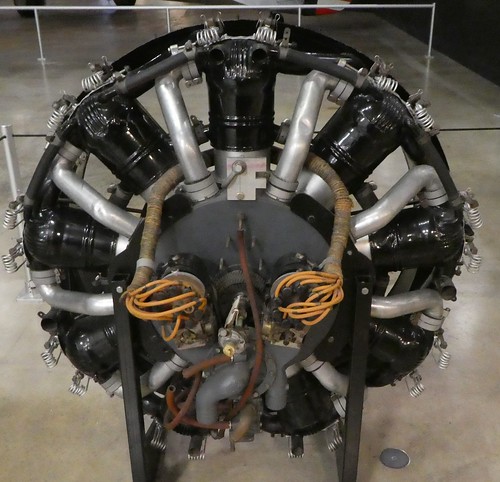 Shown above is the Salmson Z-9 engine (France, 1918). It generated 280 hp and weighed 473 pounds.
Shown above is the Salmson Z-9 engine (France, 1918). It generated 280 hp and weighed 473 pounds.
 Shown above is the ABC Wasp engine (Great Britain, 1918). It generated 170 hp and weighed 290 pounds.
Shown above is the ABC Wasp engine (Great Britain, 1918). It generated 170 hp and weighed 290 pounds.
 Shown above is the Bentley B.R.2 engine (Great Britain, 1917). It generated 230 hp and weighed 500 pounds.
Shown above is the Bentley B.R.2 engine (Great Britain, 1917). It generated 230 hp and weighed 500 pounds.
 Shown above is the Renault 12 Fe engine (France, 1917). It generated 300 hp and weighed 794 pounds.
Shown above is the Renault 12 Fe engine (France, 1917). It generated 300 hp and weighed 794 pounds.
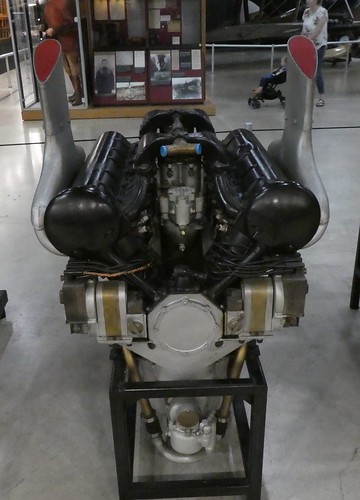 Shown above is the Curtiss K-12 engine (United States, 1917). It generated 375 hp and weighed 678 pounds.
Shown above is the Curtiss K-12 engine (United States, 1917). It generated 375 hp and weighed 678 pounds.
 Shown above is the Benz Bz.IV engine (Germany, 1916). It generated 200 hp and weighed 848 pounds.
Shown above is the Benz Bz.IV engine (Germany, 1916). It generated 200 hp and weighed 848 pounds.
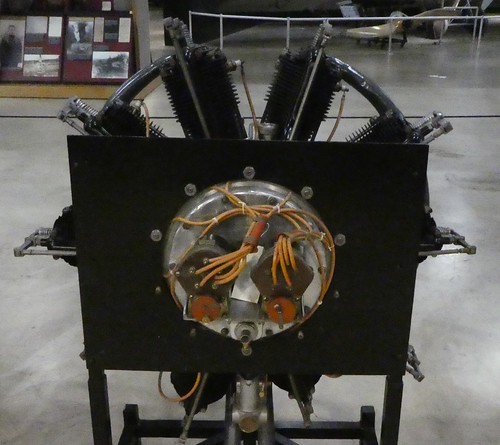 Shown above is the Anzani 10 engine (France, Great Britain, 1915). It generated 90-100 hp and weighed 121 pounds.
Shown above is the Anzani 10 engine (France, Great Britain, 1915). It generated 90-100 hp and weighed 121 pounds.
 Shown above is the R.A.F. 1A engine (Great Britain, 1913). It generated 90 hp and weighed 440 pounds.
Shown above is the R.A.F. 1A engine (Great Britain, 1913). It generated 90 hp and weighed 440 pounds.
 Shown above is the Fiat A-12 engine (Italy, 1916). It generated 280 hp and weighed 920 pounds.
Shown above is the Fiat A-12 engine (Italy, 1916). It generated 280 hp and weighed 920 pounds.
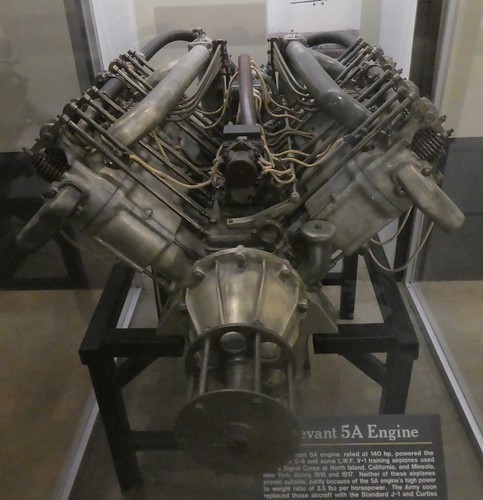 Shown above is the Sturtevant 5A engine (United States, 1916-1917).
Shown above is the Sturtevant 5A engine (United States, 1916-1917).
According to the Museum:
The Sturtevant 5A engine, rated at 140 hp, powered the Sturtevant S-4 and some L.W.F. V-1 training airplanes used by the Signal Corps at North Island, Calif., and Mineola, N.Y., during 1916 and 1917. Neither of these airplanes proved suitable, partly because of the 5A engine's high power to weight ratio of 3.5 pounds per horsepower. The Army soon replaced those aircraft with the Standard J-1 and Curtiss JN-4 trainers.
 Shown above is the Wright 6-60 engine (United States).
Shown above is the Wright 6-60 engine (United States).
According to the Museum:
The U.S. Army Signal Corps used Wright 6-cylinder, water-cooled engines to power its Wright Model C and D airplanes. Although originally rated at 50 hp, this improved version of the Wright 6-cylinder possessed 60 hp ("6-60" referred to its 6-cylinder-60-hp capacity).
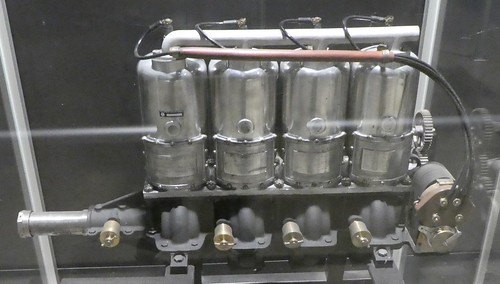 Shown above is the Roberts Model 4-X engine (United States). It developed 50 hp and weighed 170 pounds.
Shown above is the Roberts Model 4-X engine (United States). It developed 50 hp and weighed 170 pounds.
According to the Museum:
This four-cylinder, water-cooled engine was made by the Roberts Motor Co. of Sandusky, Ohio, around 1910. Roberts used secret alloys it called "Aerotite" and "Magnalium" to enhance performance and reduce weight. The motor, weighing 170 pounds and developing 50 hp, was used in some Benoist and American-owned Bleriot aircraft. It cost $1,500 by mail order when it was new.
 Shown above is the Kirkham 4-Cylinder engine (United States, 1912-1914). It developed 40 hp.
Shown above is the Kirkham 4-Cylinder engine (United States, 1912-1914). It developed 40 hp.
According to the Museum:
Charles B. Kirkham of Savona, N.Y., made this four-cylinder, water-cooled engine around 1912-1914. Its exact origin is unclear, but Hillery Beachy, a well-known early aviator, was likely involved in its design or use. Though it resembles an auto engine, similar Kirkham motors powered several early aircraft. Roe Tanner, a brick mason and inventor, used this 40-hp Kirkham in Attica, Ohio, around 1914 to ground test ideas for variable-pitch propellers.
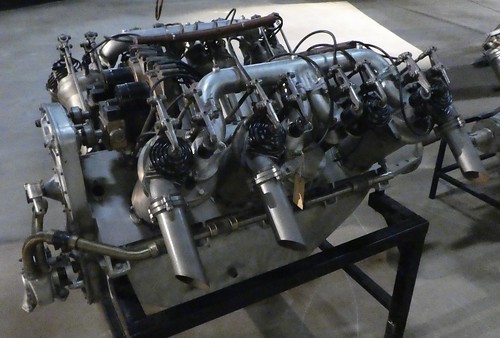 Shown above is the Curtiss V2-3 engine (United States, 1916-1917). It is rated at 200 hp.
Shown above is the Curtiss V2-3 engine (United States, 1916-1917). It is rated at 200 hp.
According to the Museum:
In 1916 and 1917 Curtiss produced R-3 and R-4 airplanes for the U.S. Army Signal Corps, some of which the 1st Aero Squadron used during the Mexican Punitive Expedition. The Curtiss V2-3 engine, rated at 200 hp, powered both those airplanes; however, it had a poor power to weight ratio -- almost four pounds for every 1 hp -- which hurt aircraft performance. By comparison, the World War I Liberty engine had a ratio of two pounds weight per horsepower.
 Shown above is the Curtiss OX-5 engine (United States). This 90 hp engine was used in the Curtiss “Jenny” airplane.
Shown above is the Curtiss OX-5 engine (United States). This 90 hp engine was used in the Curtiss “Jenny” airplane.
According to the Museum:
Thousands of OX-5 water-cooled engines were produced in the United States during World War I, primarily for the Curtiss Jenny airplane. The engine, a refinement of a 1914 design, was rated at only 90 hp. Compared to other airplane engines of the period, it was very reliable. Some OX-5 engines are still being used in restored Jenny airplanes throughout the nation.
 Shown above is the LeRhone C-9 engine (France, 1916). This 90 hp engine weighed 240 pounds.
Shown above is the LeRhone C-9 engine (France, 1916). This 90 hp engine weighed 240 pounds.
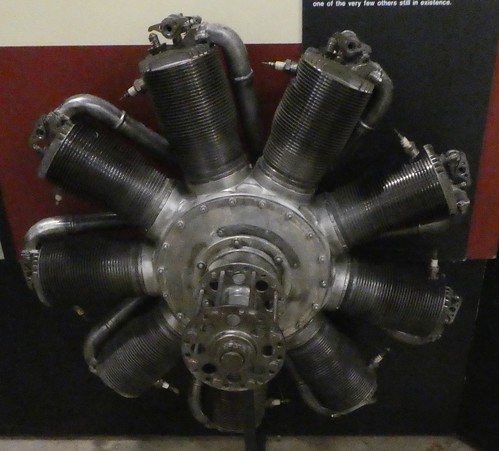 Shown above is the Oberursel UR-2 rotary engine (Germany).
Shown above is the Oberursel UR-2 rotary engine (Germany).
According to the Museum:
The Oberursel UR-2 rotary engine, rated at 110 hp, was the type used to power the Fokker Dr.1 triplane. Built by the Oberursel Motoren Gesellschaft of Frankfurt, Germany, it was an exact copy of the famous French LeRhone 110-hp rotary engine.
 Shown above is the Gnome N-9 rotary engine (France, 1909). This was one of the most important designs in early aviation.
Shown above is the Gnome N-9 rotary engine (France, 1909). This was one of the most important designs in early aviation.
According to the Museum:
The French Gnome engine was one of the most important designs in early aviation, and a main source of aircraft power for the Allies in World War I. First appearing 1909, this engine type was developed into several models and used throughout the war. The 9-cylinder model on display at the museum is typical of the Gnome design.
The Gnome was a rotary type, meaning the engine and propeller were bolted together, and both rotated around a fixed shaft. Air passing over the hot cylinders cooled the spinning engine. Gnome Monosoupape (single valve) engines like the one on display had one valve per cylinder acting as both air inlet and exhaust. Fuel was mixed with air not in a carburetor, but in the hollow central shaft, where the fuel-air mixture entered each cylinder at its base.
Gnome engines were reliable and powerful for their weight, but had certain drawbacks. First, the gyroscopic effect of the heavy, spinning engine made quick left turns easy, but hard right turns were difficult. Second, the motor used a large amount of fuel and lubricating castor oil, and some of the unburned oil was thrown from the spinning engine, making life unpleasant for pilot a few feet behind it. A cowling around the engine directed most of this under the aircraft, but thick, greasy fumes and oil inevitably coated the pilot. Castor oil was used because it burns cleanly, but pilots joked about its well-known laxative effect.
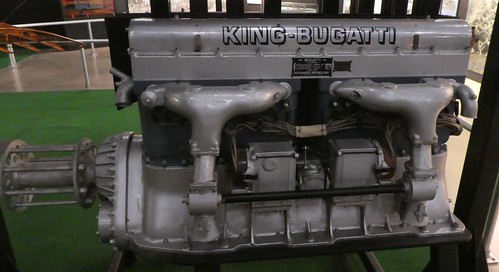 Shown above is the King-Bugatti U-16 engine (United States, 1918). This 410 hp engine weighed 1,286 pounds.
Shown above is the King-Bugatti U-16 engine (United States, 1918). This 410 hp engine weighed 1,286 pounds.
 Shown above is the Liberty L-8 engine (United State, 1917). This 270 hp engine weighed 575 pounds.
Shown above is the Liberty L-8 engine (United State, 1917). This 270 hp engine weighed 575 pounds.
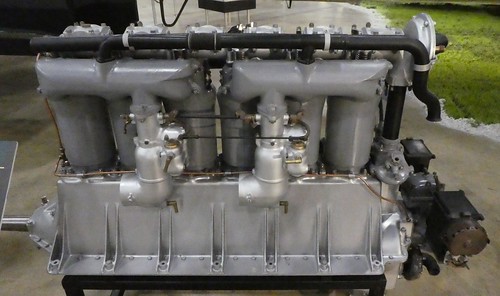 Shown above is the Liberty L-6 engine (United States, 1918). This 215 hp engine weighed 550 pounds.
Shown above is the Liberty L-6 engine (United States, 1918). This 215 hp engine weighed 550 pounds.
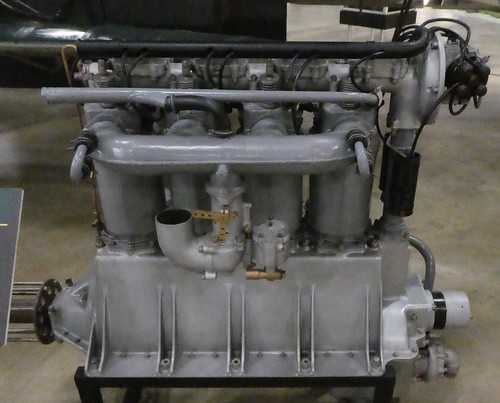 Shown above is the Liberty L-4 engine (United States, 1918). This 102 hp engine weighed 398 pounds.
Shown above is the Liberty L-4 engine (United States, 1918). This 102 hp engine weighed 398 pounds.
 Shown above is the Packard Liberty 12A engine (United States, 1923). This 449 hp engine weighed 844 pounds.
Shown above is the Packard Liberty 12A engine (United States, 1923). This 449 hp engine weighed 844 pounds.
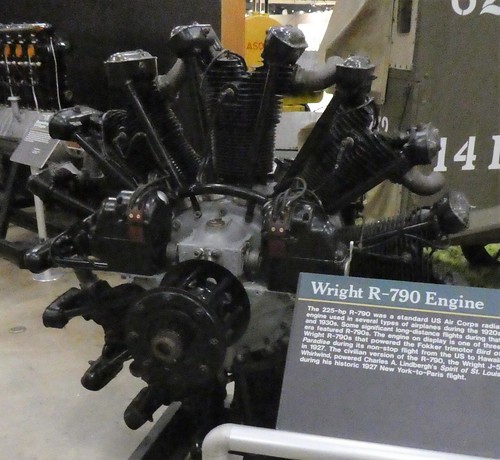 Shown above is the Wright R-790 engine (United States, 1920s).
Shown above is the Wright R-790 engine (United States, 1920s).
According to the Museum:
The 225-hp R-790 was a standard U.S. Air Corps radial engine used in several types of airplanes during the 1920s and 1930s. Some significant long-distance flights during that era featured R-790s.
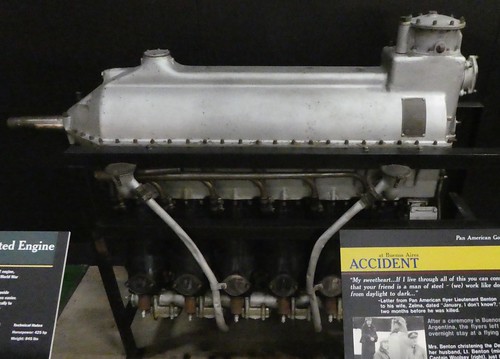 Shown above is the Liberty 12-A inverted engine (United States, 1918). This 425 hp engine weighed 845 pounds. This was one of America’s greatest technological contributions during World War I. The engine was turned upside down to improve pilot visibility. During the War, 20,748 Liberty 12s were made.
Shown above is the Liberty 12-A inverted engine (United States, 1918). This 425 hp engine weighed 845 pounds. This was one of America’s greatest technological contributions during World War I. The engine was turned upside down to improve pilot visibility. During the War, 20,748 Liberty 12s were made.
According to the Museum:
The inverted Liberty is a conversion of the famous Liberty 12, one of America's greatest technological contributions during World War I. During the war, 20,478 Liberty 12s were produced in the United States and used primarily in U.S.-built DH-4s, the only American-made airplane to get into combat over the Western Front.
Initial attempts to invert the Liberty engine took place in 1918-1919, but technical problems delayed the first flight until 1923. Inverted Liberty 12-As, produced until 1926, were conversions of the standard engine. Most were used in the Loening OA-1 amphibians, designed specifically for the inverted engine. Among the advantages were high propeller position (for hull clearance in the amphibian), better visibility and easier access for the mechanics.
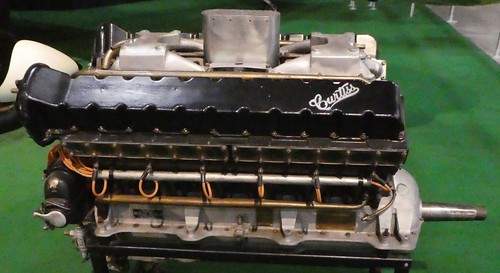 Shown above is the Curtiss D-12 engine (United States, 1921).
Shown above is the Curtiss D-12 engine (United States, 1921).
According to the Museum:
The 375-hp Curtiss D-12 engine, introduced in 1921, became one of the most successful aircraft engines of the 1920s. Developed from Curtiss' K-12 engine used in World War I, the D-12 replaced the gears connecting the crankshaft to the propeller with a more reliable direct-drive connection, hence the "D" for direct-drive. Also, Curtiss attached a new propeller designed by acoustics engineer Dr. S.A. Reed. It could rotate at a higher speed than conventional propellers, allowing the engine to use its full power. This combination made the D-12 the most advanced power plant in the world.
 Shown above is the Curtiss V-1570 Conqueror engine (United States, 1926). This 675 hp engine weighed 770 pounds.
Shown above is the Curtiss V-1570 Conqueror engine (United States, 1926). This 675 hp engine weighed 770 pounds.
 Shown above is the Wright R-1820 Cyclone engine (United States, 1931).
Shown above is the Wright R-1820 Cyclone engine (United States, 1931).
According to the Museum:
The Wright Aeronautical Corp. introduced the 9-cylinder, air-cooled, R-1820 radial engine in 1931. Developed from earlier "Cyclone" engines of the late 1920s, the larger and more powerful R-1820 produced 575 hp; however, engineers dramatically improved its performance over many years of production, with several later versions being rated at 1,525 hp.
Although the R-1820 powered thousands of military and civilian aircraft, it remains best known as the engine that powered Boeing's B-17 Flying Fortress in World War II.
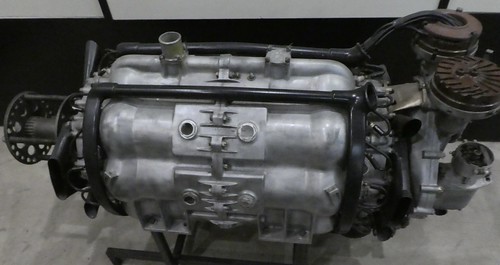 Shown above is the Almen A-4 Barrel engine (United States, 1920s). This 425 hp engine weighed 749 pounds.
Shown above is the Almen A-4 Barrel engine (United States, 1920s). This 425 hp engine weighed 749 pounds.
According to the Museum:
The water-cooled A-4 barrel engine (18 cylinders -- two groups of nine each horizontally opposed) was the fourth experimental barrel engine built for testing at McCook Field, Ohio, by its inventor, Mr. J.O. Almen of Seattle, Wash. The project began in 1921 and by the mid-1920s, the A-4 passed its acceptance tests. The engine never went into production, however, reportedly because of limited funds and a growing emphasis by the U.S. Army Air Corps on air-cooled radial engines.
This unique engine had a much smaller frontal area than other water-cooled engines of similar horsepower, thereby providing better streamlining and less air resistance. It was rated at 425 hp but weighed only 749 pounds (a power to weight ratio of better than one to two), a significant design achievement in the early 1920s.
 Shown above is the Packard 3A-2500 engine (United States, 1926). This 800 hp engine weighed 1,425 pounds.
Shown above is the Packard 3A-2500 engine (United States, 1926). This 800 hp engine weighed 1,425 pounds.
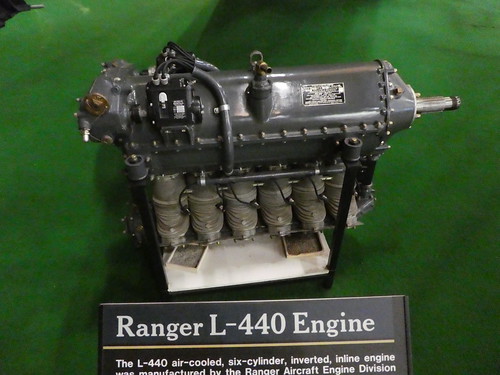 Shown above is the Ranger L-4400 engine.
Shown above is the Ranger L-4400 engine.
According to the Museum:
The L-440 air-cooled, six-cylinder, inverted, in-line engine was manufactured by the Ranger Aircraft Engine Division of Fairchild Engine and Airplane Corp. Built in several versions ranging from 175 hp to 200 hp, L-440 series engines powered more than 6,000 Fairchild PT-19 and PT-26 during World War II.
More aircraft-related photo diaries
Air Force Museum: Air Park (photo diary)
Planes of Fame: Outdoor Displays (Photo Diary)
Yanks Air Museum: Restoration (Photo Diary)
Museums 101: Vintage Aircraft in the Museum of Mountain Flying (Photo Diary)
Stonehenge Air Museum: Biplanes (Photo Diary)
Evergreen Aviation: Biplanes (photo diary)
Museum of Flight: Some early airplanes (photo diary)
WAAAM: Waco Airplanes (Photo Diary)


